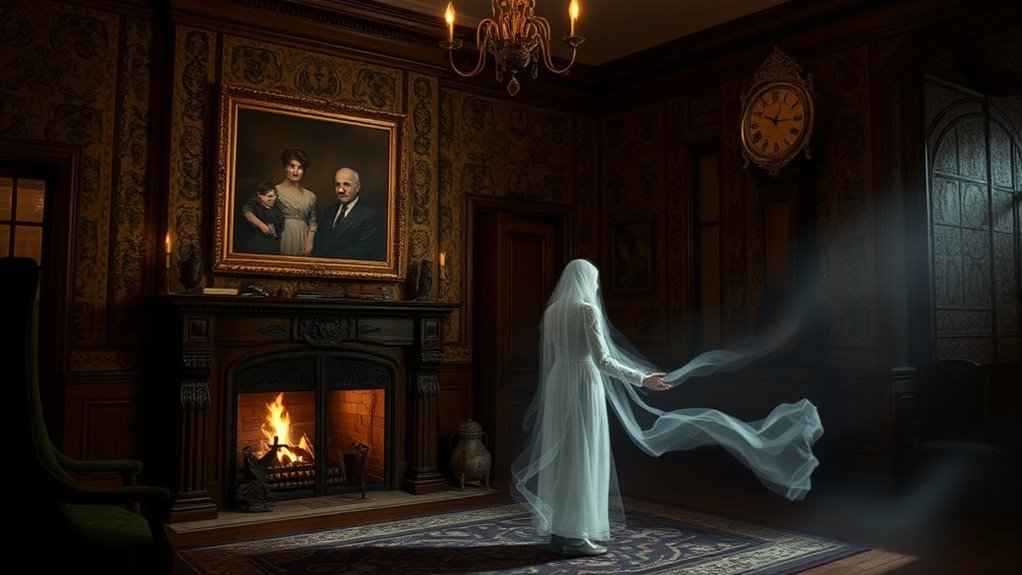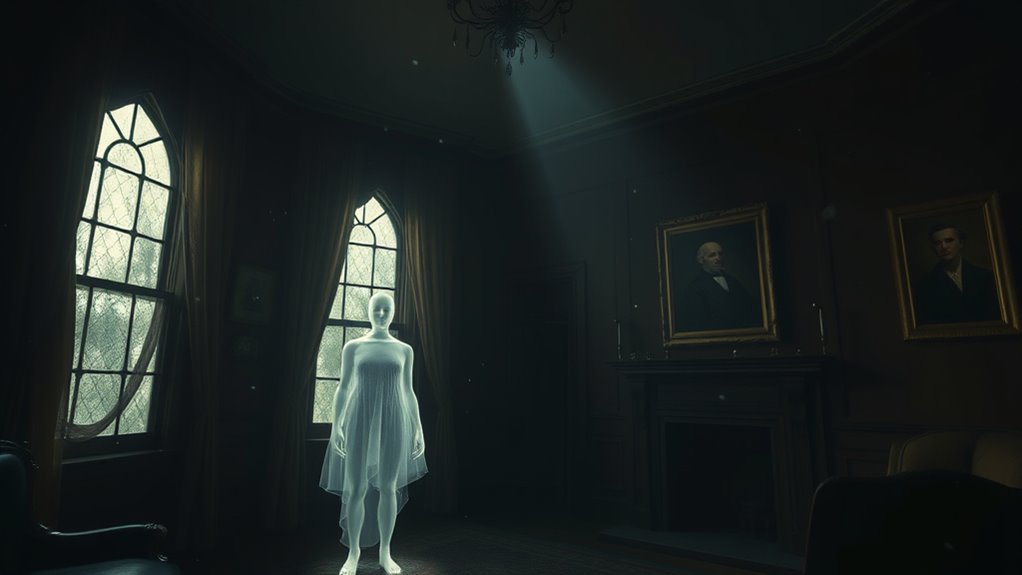An intelligent haunting involves conscious spirits that actively engage with the living, unlike residual hauntings that simply replay past events. These spirits can communicate, often through unusual phenomena like moving objects or disembodied voices. They can express various intentions, from benign to mischievous, and are often linked to emotional connections with specific locations or individuals. To truly understand their complexities and manifestations, you might want to explore what else lies beneath the surface.
Key Takeaways
- Intelligent hauntings involve conscious spirits that actively interact with the living, unlike residual hauntings which lack awareness.
- These spirits can manipulate objects, create electrical phenomena, and often seek to convey messages to specific individuals.
- Common experiences include hearing disembodied voices, feeling touches, and observing full-bodied apparitions.
- Emotional connections with the living can enhance interactions and influence the behavior of intelligent spirits.
- Investigative methods like EVP sessions and spirit communication devices are used to facilitate contact and understand these hauntings.
Definition of Intelligent Hauntings

Intelligent hauntings are fascinating manifestations of conscious spirits that can interact with the living. Unlike residual hauntings, where energies merely replay past events, intelligent hauntings involve spirits that retain awareness and can communicate.
These entities might move objects, make sounds, or engage directly with you, creating a dynamic experience. Reports of intelligent hauntings have emerged across cultures for thousands of years, often featuring physical manipulation of objects and unusual electrical phenomena.
Some spirits display benign intentions, while others might be mischievous, seeking to convey messages or provoke reactions. To truly understand intelligent hauntings, you need to recognize that these entities respond to their surroundings and often form emotional connections with specific people or places, enhancing their interactions.
Characteristics of Intelligent Hauntings

The essence of intelligent hauntings lies in their ability to engage with the living in meaningful ways. These hauntings involve spirits that retain varying levels of consciousness, allowing them to interact with you.
You might notice physical manifestations, like objects moving or strange sounds, showcasing their awareness of their surroundings. Common experiences include feeling a touch, hearing disembodied voices, or finding items unexpectedly displaced.
The entities behind intelligent hauntings exhibit a spectrum of behaviors, ranging from friendly interactions to mischievous or even malevolent actions, influenced by their personality and past circumstances.
Reports of these hauntings span thousands of years and cultures, often featuring phenomena like full-bodied apparitions and unusual electrical anomalies, further emphasizing their intriguing nature.
The Difference Between Intelligent and Residual Hauntings

While you might encounter various types of hauntings, understanding the distinction between intelligent and residual hauntings is essential for grasping their nature.
Intelligent hauntings involve spirits that demonstrate self-awareness and can actively interact with you, often communicating through physical manifestations like moving objects or producing sounds.
In contrast, residual hauntings are non-interactive, merely replaying energy from past events without any conscious awareness.
You might feel an emotional connection with an intelligent haunt, as they often carry unfinished business, while residual haunts simply reflect past occurrences, lacking intent.
Common Manifestations of Intelligent Hauntings

When you encounter an intelligent haunting, you’ll likely notice a variety of physical manifestations that signal the presence of a conscious entity.
Objects might move on their own, doors may open unexpectedly, and sounds could echo through the space, all hinting at an unseen force at work.
You might also capture Electronic Voice Phenomena (EVPs), where the entity responds to your questions.
Visually, you could see full-bodied apparitions or shadowy figures that suggest awareness and intent.
Additionally, you might experience strange disturbances with electrical devices, like flickering lights or sudden malfunctions.
These manifestations of intelligent hauntings often evoke strong emotional responses, leaving you feeling either comforted or uneasy in their presence.
The Role of Emotional Connections

Emotional connections play an essential role in intelligent hauntings, often tying spirits to people or places they once cherished.
When these ties involve unfinished business, spirits may feel compelled to communicate, seeking closure or understanding.
You might notice that their behaviors often reflect their emotional states, revealing a deeper story behind their presence.
Emotional Ties and Spirits
Spirits often linger in our world due to deep emotional ties formed during their lifetimes. These intelligent hauntings often involve spirits connected to specific people, places, or objects.
Emotional ties arise from unresolved issues, strong attachments, or significant life events, compelling these spirits to interact with the living. You might notice communication through physical phenomena, like moving objects or sounds, reflecting their need to connect.
Many reports highlight spirits reaching out to loved ones, offering comfort, closure, or guidance beyond death. The nature of these emotional ties can greatly influence a spirit’s behavior, leading to benign interactions or more intense manifestations based on the shared history with the living.
Understanding these connections can deepen your appreciation for the paranormal.
Unfinished Business Connections
Although many hauntings can be unsettling, they often stem from unfinished business that ties spirits to the living. Intelligent hauntings typically arise from deep emotional connections, compelling spirits to communicate unresolved messages. These connections may manifest through various means, indicating their desire to bridge the gap between life and death.
| Type of Connection | Examples | Feelings Expressed |
|---|---|---|
| Family Ties | Messages to loved ones | Love, longing |
| Unresolved Issues | Regrets, apologies | Sadness, guilt |
| Significant Events | Celebrations, losses | Joy, sorrow |
| Everyday Moments | Familiar places | Nostalgia, comfort |
These emotional ties may provide solace, reinforcing the belief that loved ones are watching over you.
Theories Surrounding Intelligent Hauntings

When exploring intelligent hauntings, the survival hypothesis stands out, suggesting that consciousness might continue after death.
You’ll notice that these entities often interact with their surroundings, whether by moving objects or responding to your presence.
Understanding these dynamics not only sheds light on their behavior but also deepens your grasp of the paranormal.
Survival Hypothesis Explanation
The survival hypothesis suggests that consciousness continues after death, implying that intelligent hauntings are the result of souls lingering in the physical domain. This theory is supported by various anecdotal accounts where spirits show awareness and intent. Researchers note that intelligent hauntings often involve interactions, such as responding to questions or manipulating objects, demonstrating self-awareness.
| Evidence Type | Description |
|---|---|
| Anecdotal Accounts | Personal stories of interactions with spirits |
| Self-Awareness | Haunts responding to questions |
| Emotional Connections | Bonds felt with deceased loved ones |
| Cultural Reports | Different cultures sharing similar experiences |
| Ongoing Research | Investigations seeking empirical evidence |
Such experiences challenge the notion of residual hauntings, suggesting a deeper connection with the afterlife.
Entity Interaction Dynamics
Understanding the dynamics of entity interactions in intelligent hauntings reveals a captivating interplay between the living and the deceased.
These encounters showcase entities that exhibit self-awareness, responding to your actions and questions, which indicates a consciousness beyond mere residual energy. Reports often detail physical interactions, like objects moving or sounds occurring in reply to your inquiries.
The survival hypothesis suggests these spirits linger to communicate, showcasing behaviors ranging from benevolent to mischievous or even malevolent, depending on their perceived intent.
Curiously, many believe these intelligent haunts aren’t confined to specific locations and can choose to engage with you at will, enhancing the complexity of entity interaction dynamics in your experiences with the paranormal.
Investigative Methods for Understanding Intelligent Hauntings

Investigators often employ a variety of methods to explore the mysteries of intelligent hauntings, aiming to capture the elusive communication of spirits. One common technique involves EVP sessions, where you use audio recording devices to capture potential spirit messages.
Additionally, researchers often utilize spirit communication devices, like ghost boxes or spirit boards, to facilitate interactions with entities. Historical research is essential, as it helps you understand the backgrounds and motivations of spirits, enriching your investigations.
Field observations can reveal patterns, such as responses to your questions or environmental changes. Collaborating with mediums or experienced paranormal investigators enhances your ability to communicate with spirits, leading to deeper insights into the nature of intelligent hauntings.
Personal Experiences With Intelligent Hauntings

Experiencing an intelligent haunting can be both fascinating and eerie. You might feel a strong presence or even physical sensations, like being touched. Many report strange occurrences that seem tied to their emotions or requests, such as flickering lights or doors opening. It’s not uncommon to capture Electronic Voice Phenomena (EVPs) during these encounters, revealing voices that weren’t heard at the time.
| Experience | Emotion |
|---|---|
| Feeling a presence | Fear and curiosity |
| Objects moving | Confusion |
| Responding to questions | Hope and connection |
These intelligent hauntings often reveal spirits with unfinished business, keen to communicate their messages to the living. Each encounter can leave you pondering the mysteries of the afterlife.
Psychopomps and Their Connection to Intelligent Hauntings

Psychopomps play an essential role in guiding deceased souls to the afterlife, often appearing in intelligent hauntings.
You might encounter these spiritual beings as they help spirits resolve unfinished business and find peace.
Understanding their connection to hauntings can deepen your insight into the nature of these encounters.
Role of Psychopomps
While many spirits linger due to unresolved issues or emotional ties, psychopomps play an essential role in guiding them toward the afterlife.
These benevolent entities assist souls caught in intelligent hauntings, helping them shift peacefully when they’re stuck. They often communicate through modern psychic mediums, who act as conduits, resolving lingering matters that tether spirits to the physical domain.
Understanding psychopomps sheds light on the nature of intelligent hauntings, revealing the complex interactions between the living and the deceased.
The distinction between residual energies and intelligent hauntings is significant here, as psychopomps focus on aware spirits seeking guidance.
Guidance for Deceased Souls
Understanding how psychopomps assist in guiding deceased souls reveals the depth of their connection to intelligent hauntings. These benevolent entities help spirits shift when they’re bound by unfinished business or emotional ties. Here’s how psychopomps contribute:
| Role | Description |
|---|---|
| Guidance | Direct deceased souls toward peace. |
| Communication | Facilitate dialogue between dimensions. |
| Support | Offer comfort to lingering spirits. |
| Shift | Aid in moving on to the afterlife. |
| Clarity | Distinguish intelligent hauntings from residual energy. |
Many modern psychic mediums embrace this role, ensuring the deceased find closure. By recognizing psychopomps, you can appreciate the interconnectedness of the living and the spirits, enhancing your understanding of intelligent hauntings.
Cultural Perspectives on Intelligent Hauntings

Across cultures, intelligent hauntings reveal deep-seated beliefs about the afterlife and the enduring nature of consciousness. These hauntings often reflect local traditions and values, emphasizing a connection between spirits and the living.
Here are some insights into how different cultures perceive intelligent hauntings:
- Indigenous beliefs: Ancestor spirits guide and protect descendants, highlighting familial ties.
- Eastern traditions: Concepts like “hungry ghosts” illustrate spirits bound by unresolved issues.
- Western folklore: Themes of unfinished business showcase spirits seeking closure.
- Literature and media: Global portrayals shape public perceptions of spirits and their interactions.
- Cultural narratives: Each culture’s unique stories influence how intelligent hauntings are understood and experienced.
These perspectives deepen our understanding of intelligent hauntings and their significance across different societies.
Frequently Asked Questions
What Does Its Haunting Mean?
When you experience a haunting, it often means there’s an entity trying to communicate or connect with you.
This spirit might’ve emotional ties or unfinished business that compels it to reach out. You could notice strange sounds, moving objects, or even feel a presence.
These interactions might be its way of conveying messages or seeking comfort, and recognizing this can change how you perceive the paranormal in your environment.
What Are the Two Types of Hauntings?
When you investigate the world of spirits, you’ll uncover two fascinating types of hauntings.
On one hand, you’ve got residual hauntings, where echoes of the past play out like a well-worn film, leaving you with a chilling sense of déjà vu.
On the other hand, intelligent hauntings showcase entities that interact with you, offering messages or even playful nudges.
Each type presents a unique experience, inviting you to explore the mysteries of the supernatural.
What Does It Mean if You Haunt Someone?
If you haunt someone, it means your presence lingers in their life, often driven by emotional connections or unresolved issues.
You might be trying to communicate your feelings or seek closure for something left undone.
This haunting can manifest in various ways, like moving objects or appearing in dreams.
The person you’re haunting may feel comforted or disturbed, depending on the nature of your connection and their willingness to engage with your spirit.
What Is an Example of Haunting?
Did you know that around 30% of people believe they’ve experienced a haunting?
An example of haunting could be feeling a chill in the air or hearing unexplained footsteps in an empty room. You might notice objects moving or lights flickering without explanation.
Sometimes, you could even hear whispers or your name being called when no one’s around. These experiences often leave you wondering about the presence of something beyond our understanding.
Conclusion
In the tapestry of the unseen, intelligent hauntings weave threads of emotion and memory, connecting the living with those who’ve crossed over. Like whispers in the wind, they reach out, seeking understanding and closure. By exploring these encounters, you can illuminate the shadows of the past, transforming fear into empathy. Embrace the stories they tell, for in their echoes lies a profound reminder of our shared journey through time, bridging worlds unseen yet deeply felt.









